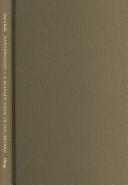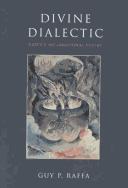| Listing 1 - 5 of 5 |
Sort by
|

ISBN: 9780226702674 9780226702681 0226702685 0226702677 Year: 2007 Publisher: Chicago, Ill. University of Chicago Press
Abstract | Keywords | Export | Availability | Bookmark
 Loading...
Loading...Choose an application
- Reference Manager
- EndNote
- RefWorks (Direct export to RefWorks)

ISBN: 1282033859 9786612033858 1442673982 0802048560 9781442673984 9781282033856 9780802048561 Year: 2000 Publisher: Toronto
Abstract | Keywords | Export | Availability | Bookmark
 Loading...
Loading...Choose an application
- Reference Manager
- EndNote
- RefWorks (Direct export to RefWorks)
"In this book, Guy Raffa offers a fresh reading of Dante's major literary works - the Divine Comedy and the Vita nuova - that combines central tenets of incarnational theology and dialectical thought to illuminate the poet's renowned ability to 'have it both ways' on issues that conventionally elicit an 'either/or' response. Viewing Dante as a poet of revision, not conversion, Raffa challenges a dominant paradigm in Dante criticism and takes full account of the poet's unconventional approach to such conventional dichotomies as eros and spirituality, fame and humility, action and contemplation, and obedience and transgression. Divine Dialectic ultimately argues that Dante crosses textual and theological boundaries in his medieval epic to promote the paradoxical union of contradiction and resolution as a way of reading his poem and, by extension, the world itself."--Jacket
Incarnation in literature. --- Dialectic in literature. --- Dante Alighieri, --- Divina commedia (Dante Alighieri) --- Cumégia (Dante Alighieri) --- Divine comedy (Dante Alighieri) --- Divina comedia (Dante Alighieri) --- Commedia (Dante Alighieri) --- Comedy (Dante Alighieri) --- Poema sacro (Dante Alighieri) --- Comedia (Dante Alighieri)
Book
ISBN: 9780674980839 0674980832 Year: 2020 Publisher: Cambridge, Massachusetts The Belknap Press of Harvard University Press
Abstract | Keywords | Export | Availability | Bookmark
 Loading...
Loading...Choose an application
- Reference Manager
- EndNote
- RefWorks (Direct export to RefWorks)
"Dante, whose Divine Comedy gave the world its most vividly imagined story of the afterlife, endured an extraordinary afterlife of his own. Exiled in death as in life, the Florentine poet has hardly rested in peace over the centuries. Like a saint's relics, his bones have been stolen, recovered, reburied, exhumed, examined, and, above all, worshiped. Actors in this graveyard history range from Lorenzo de' Medici, Michelangelo, and Pope Leo X to the Franciscan friar who hid the bones, the stone mason who accidentally discovered them, and the opportunistic sculptor who accomplished what princes, popes, and politicians could not: delivering to Florence a precious relic of the native son it had banished. In Dante's Bones, Guy Raffa narrates for the first time the complete course of the poet's hereafter, from his death and burial in Ravenna in 1321 to a computer-generated reconstruction of his face in 2006. Dante's posthumous adventures are inextricably tied to major historical events in Italy and its relationship to the wider world. Dante grew in stature as the contested portion of his body diminished in size from skeleton to bones, fragments, and finally dust: During the Renaissance, a political and literary hero in Florence; in the nineteenth century, the ancestral father and prophet of Italy; a nationalist symbol under fascism and amid two world wars; and finally the global icon we know today"--
National characteristics, Italian --- Dante Alighieri, --- Dante Alighieri, --- Dante Alighieri, --- Relics. --- Death and burial. --- Tomb.
Book
ISBN: 0674246969 0674246985 Year: 2020 Publisher: Cambridge, MA : Harvard University Press,
Abstract | Keywords | Export | Availability | Bookmark
 Loading...
Loading...Choose an application
- Reference Manager
- EndNote
- RefWorks (Direct export to RefWorks)
Like a saint’s relics, Dante’s bones have been stolen, exhumed, and worshiped. Guy Raffa narrates the Florentine poet’s hereafter—the physical afterlife of the writer who vividly imagined the spiritual afterlife. In the story of the bones lies the tale of Dante’s evolution from Renaissance to Italian to nationalist hero, and finally global icon.
National characteristics, Italian. --- Dante Alighieri, --- Relics. --- Death and burial. --- Tomb. --- Benito Mussolini. --- Corrado Ricci. --- Dante's body. --- Dante's death. --- Dante's exile. --- Dante's face. --- Dante's tomb. --- Danteum. --- Enrico Pazzi. --- Gabriele D'Annunzio. --- Giovanni Boccaccio. --- Giuseppe Mazzini. --- Italian history. --- Lord Byron. --- Risorgimento. --- Santa Croce. --- Ugo Foscolo. --- cenotaph.
Book
ISBN: 9780674246980 Year: 2020 Publisher: Cambridge, MA
Abstract | Keywords | Export | Availability | Bookmark
 Loading...
Loading...Choose an application
- Reference Manager
- EndNote
- RefWorks (Direct export to RefWorks)
| Listing 1 - 5 of 5 |
Sort by
|

 Search
Search Feedback
Feedback About UniCat
About UniCat  Help
Help News
News